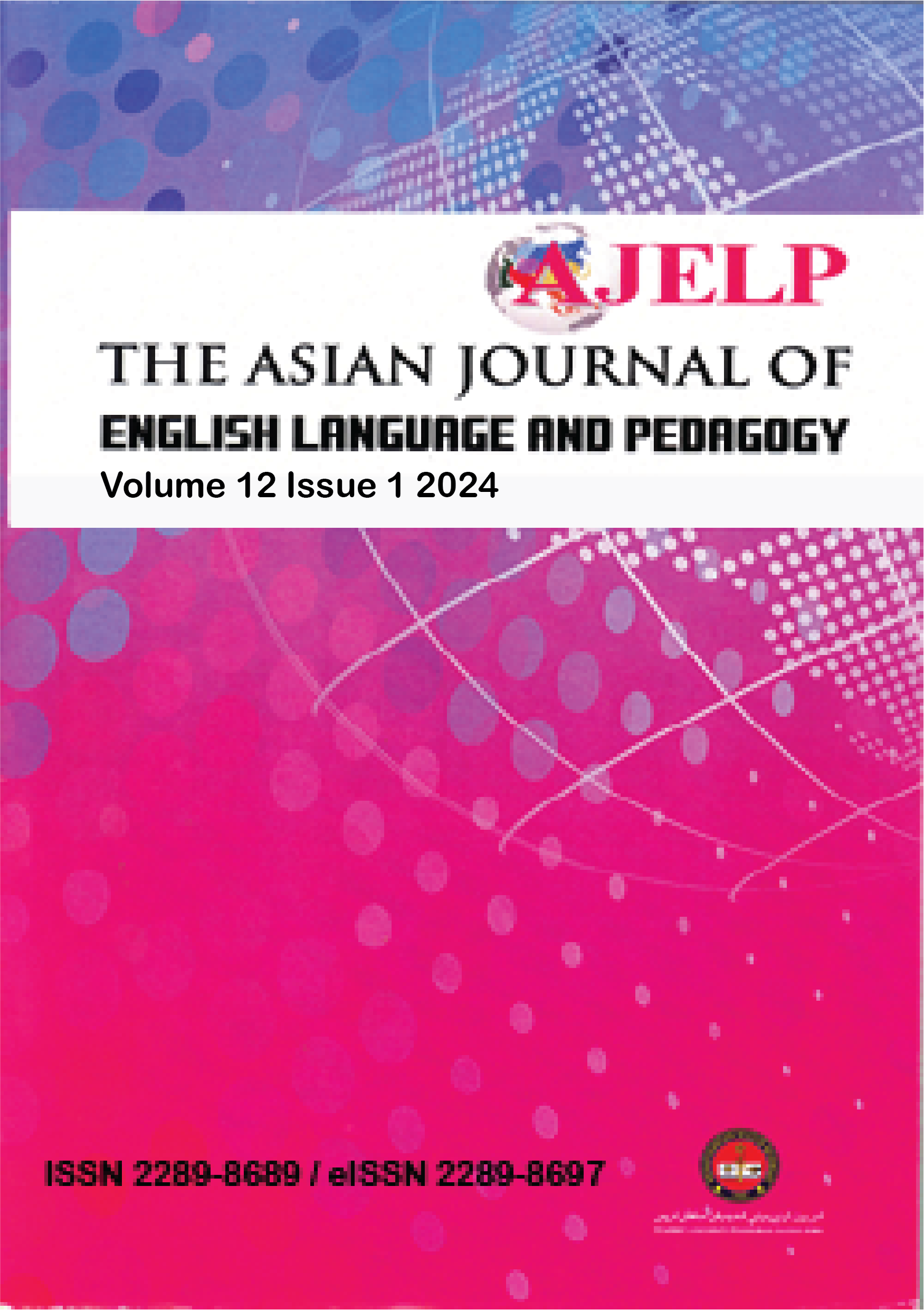Students’ Perceptions on the Use of Student Response Systems (SRS) in English Language Classrooms
DOI:
https://doi.org/10.37134/ajelp.vol12.1.4.2024Keywords:
classroom activities, engagement, English Language, perception, student response system (SRS)Abstract
This study was carried out to find out the students’ perceptions on the use of student response systems (SRS) in English language classrooms. This qualitative study gathered data through semi-structured interviews with 23 undergraduate students from a local university. The data from the interviews were audio-recorded, transcribed and analyzed qualitatively using the thematic analysis approach. The findings revealed that all the students positively support the use of SRS in classroom activities due to various reasons. Students attested that the lessons with SRS encouraged in-class participation and promoted positive engagement while doing their activities. The results of this study also indicated that SRS could be used to motivate students to be further engaged in English language classrooms.
Downloads
References
Adi Bhat. (2019). Non-probability sampling: Definition, methods and examples. Retrieved on 1 September 2019, from https://www.coursehero.com/file/55624862/Non-Probability-Sampling-Definition-Methods-and-Examplespdf/
Åhman, S., Nguyen, J., Aghaee, N., & Fuchs, K. (2021). Student Response Systems in a technology enhanced flipped classroom: A qualitative investigation in higher education. International Journal of Learning, Teaching and Educational Research, 20(9), 86–101. https://doi.org/10.26803/ijlter.20.9.6
Baker, R., D'Mello, S., Rodrigo, M., & Graesser, A. (2010). Better to be frustrated than bored: The incidence, persistence, and impact of learners’ cognitive–affective states during interactions with three different computer-based learning environments. International Journal of Human-Computer Studies, 68(4), 223-241. https://doi.org/10.1016/j.ijhcs.2009.12.003
Devendren, A., & Nasri, N. M. (2022). Systematic review: Students’ perceptions of the use of gamification. International Journal of Academic Research in Business and Social Sciences, 12(8). doi:10.6007/ijarbss/v12-i8/14268
Egelandsdal, K., & Krumsvik, R. J. (2017). Clickers and formative feedback at university lectures. Education and Information Technologies, 22(1), 55-74.
Faber, P. (2010). English as an academic lingua franca. Alicante Journal of English Studies / Revista Alicantina de Estudios Ingleses, 0(23), 19-32. https://doi.org/10.14198/raei.2010.23.02
Finefter-Rosenbluh, I., & Berry, A. (2023). With or without you? exploring student perception survey assessment data as a teacher-student (un)shared process. Teachers and Teaching, 1–14. doi:10.1080/13540602.2023.2236955
Fui-Theng, L., & Mai, N. (2014). Interactive multimedia learning: Innovating classroom education in a Malaysian university. Turkish Online Journal of Educational Technology, 13(2), 99-110.
Ghazali, S. N. (2016). Learner background and their attitudes towards studying literature. Malaysian Journal of ELT Research, 4(1), 1-17.
Gressick, J., & Langston, J. (2017). The guilded classroom: Using gamification to engage and motivate undergraduates. Journal of the Scholarship of Teaching and Learning, 17(3), 109-123.
Holmes, J., & Wilson, N. (2017). An introduction to sociolinguistics. Routledge.
Koltai, A. (2012). Exploring student motivation: Teaching students specializing in EU English. WoPaLP, 6, 46-63.
Lin, D.T.A., Ganapathy, M., & Kaur, M. (2018). Kahoot! It: gamification in higher education. Pertanika Journal of Social Sciences and Humanities, 26(1), 565-582.
Menon, S. (2017). Use of English at tertiary level. The Star Online. Retrieved from https://www.thestar.com.my/news/education/2017/11/12/use-of-english-at-tertiary-level/
Nadarajan, P., & Muhamad, M. (2021). A Comparison on Behavioral Patterns of Engagement Between Two Different Classroom Settings: With and Without Student Response Systems (SRS). Asian Journal of Assessment in Teaching and Learning, 11(1), 73-84. https://doi.org/10.37134/ajatel.vol11.1.7.2021
North, B. (2015). The CEFR in practice. Cambridge: Cambridge University Press.
Plump, C., & LaRosa, J. (2017). Using Kahoot! in the classroom to create engagement and active learning: A game-based technology solution for eLearning novices. Management Teaching Review, 2(2), 151-158. https://doi.org/10.1177/2379298116689783
Shahba, A. A.-W., Soufan, W., Altwijri, O., Alsadoon, E., & Alkathiri, S. (2023). The impact of Student Response Systems (SRS) on student achievements: A university-scale study with Deep Exploratory Data Analysis (EDA). Systems, 11(8), 384. doi:10.3390/systems11080384
Shin, Y., Park, J., & Lee, S. (2017). Improving the integrated experience of in-class activities and fine-grained data collection for analysis in a blended learning class. Interactive Learning Environments, 26(5), 597-612. https://doi.org/10.1080/10494820.2017.1374980
Skoyles, A., & Bloxsidge, E. (2017). Have you voted? Teaching OSCOLA with Mentimeter. Legal Information Management, 17(4), 232-238. https://doi.org/10.1017/S1472669617000457
Spencer, D., & Temple, T. (2021). Examining students’ online course perceptions and comparing student performance outcomes in online and face-to-face classrooms. Online Learning, 25(2). doi:10.24059/olj.v25i2.2227
The Star. (2019). The Star Online. Maszlee: Student-based learning the way forward. Retrieved 3 November 2020, from https://www.thestar.com.my/news/nation/2019/01/24/
Thomas, C. N., Pinter, E. B., Carlisle, A., & Goran, L. (2015). Student response systems. Journal of Special Education Technology, 30(4), 223–237.
Wang, A., & Tahir, R. (2020). The effect of using Kahoot! for learning – A literature review. Computers & Education, 149, 1-22.
Wang, A., Saetre, R., & Zhu, M. (2016). The effect of digitizing and gamifying quizzing in classrooms. In 10th European Conference on Game Based Learning (ECGBL). Paisley, Scotland.
Wang, A. I., & Lieberoth, A. (2016). The effect of points and audio on concentration, engagement, enjoyment,learning, motivation, and classroom dynamics using Kahoot!. In Proceedings from the 10th European Conference on Games Based Learning, (pg. 737–748). Reading, UK: Academic Conferences International Limited.
Wang, A. (2015). The wear out effect of a game-based student response system. Computers & Education, 82, 217-227. https://doi.org/10.1016/j.compedu.2014.11.004
Woldemichael, D. E. (2018). Enhancing active learning in large classes using web clicker. Pertanika Journal of Social Sciences and Humanities, 26(1), 111–120.
Zarzycka-Piskorz, E. (2016). Kahoot it or not?: Can games be motivating in learning grammar? Teaching English with Technology, 16(3), 17–36.
Downloads
Published
Issue
Section
License
Copyright (c) 2024 Pooveneswaran Nadarajan, Maizatulliza Muhamad, Hasviniy Padmanathan, Remesh Dayanandan, Lailatul Kodriyah

This work is licensed under a Creative Commons Attribution-NonCommercial-ShareAlike 4.0 International License.





